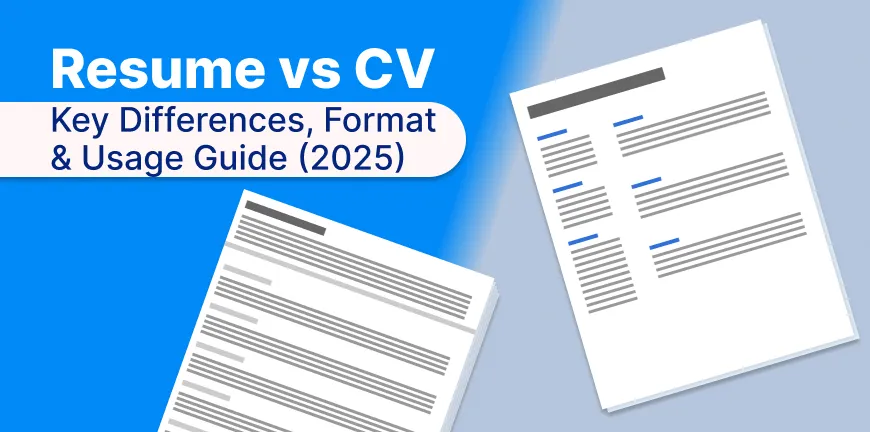
What is a performance management cycle?
06/10/2025
Work from Home vs Work from Office: Which One Boosts Productivity?
08/10/2025- What Is a CV (Curriculum Vitae)?
- When to Use a CV: Academic and Research Roles
- What Is a Resume and How to Structure It?
- Key Resume Sections: Summary, Experience, Skills
- Length Guidelines
- Relevance of a Resume in Industries
- CV vs Resume: Key Differences You Should Know
- Tips for Writing an Effective CV or Resume
- Comparison table
- Conclusion
- Frequently Asked Questions
“A resume markets your value today; a CV reflects the depth of your journey.”— Inspired by leadership principles in tech & business.
CVs and resumes are two terms you must have used several times. But do you know that these two have different meanings? Landing and excelling in an interview depend on how well you know the difference between the two. The two documents serve different and unique purposes with distinctive formats.
A CV showcases your academic career’s complete history, but a resume provides a brief overview of your qualifications that match a specific job.
Let us explore what sets resumes and curriculum vitae apart to help you pick the right document for your needs. We’ll explain the unique characteristics of these documents and their ideal uses, whether you’re seeking an academic position or a corporate role.
What Is a CV (Curriculum Vitae)?
A CV paints a detailed picture of your professional and academic experience. It is different from a resume because it offers a detailed statement of your educational background, teaching experience, and research accomplishments.
CV or “Curriculum vitae” comes from Latin and means “course of life”. This meaning shows its true purpose – to give a complete overview of your academic achievements and career growth. Many countries use the CV as the primary document employers look at when they screen candidates for job interviews, scholarship programs, and grant applications.
Typical Sections in a CV: Education, Research, Publications
A well-laid-out CV has these standard components:
- Contact Information: Full name, email address, phone number
- Education: Detailed academic history including degrees, institutions, and graduation dates
- Research Experience: Detailed accounts of research projects and contributions
- Publications: Complete list of papers, articles, and scholarly works
- Presentations: Academic conferences and speaking engagements
- Honors and Awards: Scholarships, fellowships, and academic recognition
- Teaching Experience: Courses taught and educational roles
- Professional Affiliations: Membership in academic or industry organizations
- References: List of professional references
Length and Detail: No Page Limit
Unlike resumes, CVs don’t have strict page limits. Your CV grows with your career and expands as you add new achievements. Entry-level CVs might be 1-2 pages long, while 20-year-old academics or researchers might have CVs that stretch beyond 10 pages.
When to Use a CV: Academic and Research Roles
We used CVs mainly to apply for:
- Academic positions in four-year institutions
- Research opportunities
- Grants and fellowships
- Positions in science and higher education
- Healthcare roles that need specialized credentials
What Is a Resume and How to Structure It?
A resume gives a condensed snapshot of your most relevant professional qualifications, unlike a complete CV. You can use this powerful marketing tool to apply for positions in the private sector and industry roles.
The word “resume” comes from the French word “résumé,” which means “summary”. Resumes from the early 1900s had personal details like weight, height, and religion. They became mandatory job application documents by 1950 and started featuring interests and hobbies. A resume shows your most relevant skills, achievements, and experiences that match the position you want.
Key Resume Sections: Summary, Experience, Skills
A well-laid-out resume has:
- Contact information: Name, phone number, email, location
- Resume summary/objective: A brief 2-4 sentence pitch highlighting qualifications
- Work experience: Listed in reverse-chronological order with achievements
- Skills: Relevant hard and soft skills
- Education: Academic credentials in reverse chronological order
- Optional sections: Projects, languages, certifications
Resumes focus more on work experience and transferable skills than academic awards and publications, which sets them apart from CVs.
Length Guidelines
Your resume should be brief, one to two pages at most. One page works best for professionals with less than 10 years of experience. Mid-career professionals might need two pages. This length limit helps recruiters spot your qualifications quickly, since they spend about seven seconds scanning each resume.
Relevance of a Resume in Industries
You should use a resume when applying for:
- Industry positions where a Ph.D. isn’t necessarily required
- Most non-research-oriented, non-academic jobs
- Private sector roles where employers value optimization and state-of-the-art solutions
Each application needs a tailored resume that connects your past experiences to your career goals.
CV vs Resume: Key Differences You Should Know
The main difference between these two professional documents comes from their purpose and structure. Both showcase your credentials but use very different approaches.
1. Length and Detail: Complete vs Concise
CVs can run multiple pages with no upper limit and grow longer as your career progresses. Resumes stay brief—one to two pages at most. This reflects their core purposes. CVs document your complete history, while resumes highlight only relevant qualifications.
2. Customization: Static CV vs Tailored Resume
Your CV usually stays the same across applications with minimal changes. Resumes just need customization for each position. A tailored resume shows genuine interest and helps you stand out among hundreds of applicants. On top of that, many employers use Applicant Tracking Systems to filter resumes based on job description keywords.
3. Focus Areas: Academic Achievements vs Work Experience
CVs showcase academic accomplishments, research, publications, and teaching experience. Resumes focus on work history, professional achievements, and job-relevant transferable skills.
4. Formatting Styles: Chronological vs Open Format
Resumes follow specific formats—chronological (recent experience first), functional (skills-focused), or combination. CVs use an open format with consistent sections in chronological order.
5. Geographic Usage: US vs Europe vs Asia
US employers use CVs mainly for academic, scientific, and research positions. European and Asian countries often use “CV” to describe all job application documents, including what Americans call resumes. Plus, countries like India, Australia, and South Africa use these terms interchangeably.
6. References and Photos: What to Include and Avoid
CVs typically list professional references. Photo requirements vary substantially by region. German, French, and many Asian employers expect photos, while US, UK, and Australian employers discourage them. Personal information like age and marital status follows similar regional patterns.
Tips for Writing an Effective CV or Resume
A well-crafted application document needs careful planning and attention to detail. The same basic principles work for both CVs and resumes.
1. Tailor Content to the Job Description
Your chances of standing out improve when you customize your application. The numbers tell the story – 99.7% of recruiters use ATS filters to find qualified candidates. The best approach is to analyse each job posting for keywords and weave these terms naturally into your document. This shows you’re serious about the role and helps your application clear automated screening systems that look for specific terminology.
2. Use Action Verbs and Measure Achievements
Strong action verbs should lead your bullet points, not passive phrases. “Achieved,” “implemented,” or “developed” work better than vague terms like “responsible for”. Numbers make your achievements more concrete. A statement like “improved sales by 20% over six months” makes a bigger impact than just saying “improved sales”.
3. Avoid Common Formatting Mistakes
Your formatting needs to stay consistent – this means spacing, font size (10-12pt), and punctuation. The data shows that 77% of hiring managers reject applications with typos or grammar errors. Simple bullet points are most effective, as ATS systems may overlook fancy formatting.
4. Proofread for Grammar and Clarity
Reading your document out loud helps catch awkward phrases and hidden errors. Multiple reviews help too – focus on different elements each time you read through.
Also, run the text through a reliable grammar checker to ensure that there are no typos, grammatical errors, or punctuation mistakes.
Comparison table
| Attribute | CV (Curriculum Vitae) | Resume |
| Length | No page limit | 1-2 pages maximum |
| Main Goal | Complete record of academic achievements | Brief overview of qualifications for a specific role |
| Content Focus | Academic work, research, publications, and teaching background | Work experience, career achievements, relevant skills |
| Customization | Remains mostly consistent | Needs adjustment for each role |
| Format | Flexible with chronological sections | Specific layouts (chronological, functional, or mixed) |
| Geographic Usage | Common for academic roles in the US; standard document in Europe | Standard in the US business sector; known as a CV in some regions |
| References | Usually included | Usually left out |
| Target Applications | Academic roles- Research positions- Grants and fellowships- Scientific jobs- Healthcare positions | Business roles- Private sector jobs- Non-research positions |
| Key Sections | Contact Information- Education- Research Experience- Publications- Presentations- Honors/Awards- Teaching Experience- Professional Memberships | Contact Information- Resume Summary/Objective- Work Experience- Skills- Education- Optional sections (Projects, Languages, Certifications) |
Conclusion
The biggest difference between resumes and CVs ends up being about their purpose, audience, and where they’re used. In this article, we have delved into the intricacies of how these documents work differently in the professional world.
Most European countries see CVs as their go-to application documents. Americans call it a CV only in academic settings. This cultural gap shows why job seekers should check what each region expects before they apply.
Choosing the right document shows you understand industry standards and value employers’ time. Whatever format you pick, focus on quality content that highlights your qualifications and achievements accurately.
Frequently Asked Questions
1. What are the main differences between a CV and a resume?
A CV is a comprehensive document detailing your entire academic and professional history, while a resume is a concise summary of your most relevant qualifications for a specific job.
2. When should I use a CV instead of a resume?
Use a CV when applying for academic positions, research opportunities, grants, fellowships, or roles in scientific fields. Resumes are more appropriate for most industry positions and private sector jobs where employers value concise, tailored information.
3. How do CV and resume formats differ across countries?
In the United States, CVs are primarily used for academic and research positions, while resumes are standard for most other jobs. In Europe and some parts of Asia, the term “CV” is often used to describe all job application documents, including what Americans call resumes.
4. Should I include references and a photo in my CV or resume?
CVs typically include professional references, while resumes generally do not. The inclusion of photos varies by region. They are expected in some European and Asian countries but discouraged in the US, UK, and Australia.
5. How can I make my CV or resume stand out to employers?
To make your document stand out, tailor the content to the job description, use strong action verbs, quantify your achievements where possible, and ensure impeccable formatting and grammar. For resumes, focus on customization for each position, while CVs should comprehensively showcase your academic and research accomplishments.
Contact Us For Business Enquiry

Amit Saproo
Amit Saproo is the Head of Operations at ALP Consulting with nearly 17 years of experience in Executive Search, RPO, Leadership, and IT & Engineering recruitment. He leads nationwide recruitment programs across Technology, BFSI, and R&D domains, driving strategic hiring solutions for diverse client needs. Amit excels in building and managing high-performance teams that deliver scalable, end-to-end recruitment and consulting services.




